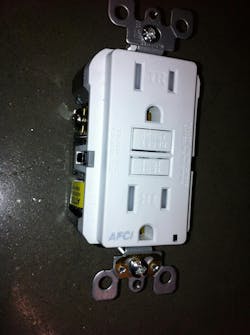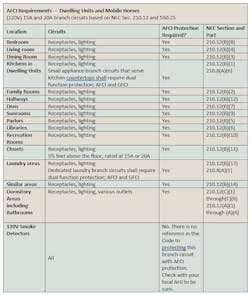Note: This article references the 2020 NEC because the Philadelphia area — the jurisdiction where this author teaches and works — operates under that version of the Code.
Outlining the use of arc-fault circuit interrupters (AFCIs) in residential and some commercial settings, Sec. 210.12 of the National Electrical Code (NEC) — which falls under Art. 210 (Branch Circuits) — is critical for electrical apprentices to master. This is because it not only helps them install wiring safely in compliance with the Code but also positions them as a knowledgeable professional in the trade. Before we jump into how to apply the NEC requirements in this area, let’s take a quick look at the purpose and history of AFCIs, starting with their definition.
Per Art. 100, an AFCI is a “device intended to provide protection from the effects of arc faults by recognizing characteristics unique to arcing and by functioning to de-energize the circuit when an arc fault is detected.”
In response to concerns that the conventional circuit breaker was not providing branch circuit arcing protection, the Consumer Product Safety Commission (CPSC) and the Electronic Industries Association (EIA) introduced the Arc-Fault Circuit Interrupter (AFCI) circuit breaker into the NEC in 1999, and the 2002 version of the Canadian Electrical Code in Canada. The goal was to reduce home electrical fires, deaths, injuries, and property loss. According to the Electrical Safety Foundation International (ESFI), electrical distribution systems are the third leading cause of home structure fires. The organization also notes that each year in the United States, arcing faults are responsible for starting more than 28,000 home fires, killing and injuring hundreds of people, and causing more than $700 million in property damage. These devices were designed to provide a higher level of protection than standard circuit breakers.
How they work
AFCI circuitry has become one of the most important and loathed safety devices in residential construction for electricians “wiring up” dwelling units and mobile homes. AFCIs are specifically designed to monitor the changes in current in a branch circuit and then open the circuit during hazardous arcing conditions; standard circuit breakers only trip when they detect an overload or short circuit, but they don't protect against arc faults that can lead to fires. AFCI device circuitry can determine the presence of normal “harmless” arcing that occurs during regular operation of electrical equipment, such as small motor arcs found from vacuum cleaners, solid-state electronic devices, or a dimmed load vs. an electrical arc fault that can cause a fire (like a loose connection from a broken conductor or loose wire connector).
Following the guidelines
To many, the guidelines and installation requirements for arc fault circuit breakers can be confusing and daunting. Since 1999, the NEC and later editions have increased the locations where AFCIs are required along with the 2008 NEC additions of family rooms, dining rooms, living rooms, parlors, libraries, dens, bedrooms, sunrooms, recreation rooms, closets, hallways, laundry areas, and similar rooms and areas. The 2014 edition of the NEC added kitchens and laundry rooms — where many cord- and plug-connected appliances are used on 120V single-phase 15A and 20A circuits. AFCI protection is required on all branch circuits supplying outlets or devices installed in dwelling unit kitchens; they are also required in dormitory units.
Dwelling unit AFCI requirements
If an existing circuit is being modified, replaced, or extended within a dwelling unit, the circuit must have AFCI protection installed per Art. 210.12(D) unless it is extended less than 6 feet without an outlet or device. All 120V, single-phase, 15A, and 20A branch circuits supplying outlets or devices installed in areas identified in the Table below shall be protected by any of the means described in Art. 210.12(A)(1) through (6):
- A listed combination-type arc-fault circuit interrupter shall be installed to protect the entire branch circuit, as noted in Sec. 210.12(A)(1).
- A listed branch/feeder-type AFCI shall be installed at the origin of the branch circuit in combination with a listed outlet branch-circuit-type arc-fault circuit interrupter at the first outlet box on the branch circuit. The first outlet box in the branch circuit shall be marked to indicate that it is the first outlet of the circuit per Sec. 210.12(A)(2).
- A listed supplemental arc protection circuit breaker shall be installed at the origin of the branch circuit in combination with a listed outlet branch-circuit-type arc-fault circuit interrupter installed at the first outlet box on the branch circuit where all the following conditions are met, as noted in Sec. 210.12(A)(3).
- The branch-circuit wiring shall be continuous from the branch-circuit overcurrent device to the outlet branch-circuit arc-fault circuit interrupter as described in Sec. 210.12(A)(3)(a).
- The maximum length of the branch-circuit wiring from the branch-circuit overcurrent device to the first outlet shall not exceed 50 ft for a 14 AWG conductor or 70 ft for a 12 AWG conductor per Sec. 210.12(A)(3)(b).
- The first outlet box in the branch circuit shall be marked to indicate that it is the first outlet of the circuit per Sec. 210.12(A)(3)(c).
Mobile homes
All 120V, single-phase, 15A and 20A branch circuits supplying outlets or devices installed in mobile homes and manufactured homes shall comply with Sec. 210.12 and Sec. 550.25. Arc-fault circuit-interrupter (AFCI) protection shall be required. Lighting outlets, receptacle outlets, smoke alarm outlets, branch circuits, and other power outlets within the voltage and current ratings specified by Sec. 550.25 shall also be covered by the requirements of Sec. 210.12.
Clothes closets
If a receptacle is located within a clothes closet (more than 51/2 feet above the floor, rated at 15A or 20A, 125V through 250V, and "non-locking" within a dwelling unit, it is required to have AFCI protection per Sec. 210.12(B) and must be tamper-resistant rated.
Lighting in residential laundry areas
For branch circuits that operate at 120V, single-phase, and typically feed the lighting outlets in laundry areas, 15A or 20A-rated AFCI protection would be required as stated in Sec. 210.12(B)(13) and Sec. 210.12(A). At least one lighting outlet must have a listed wall-mounted control device as stated in Sec. 210.70 (A) of the NEC branch circuit requirements.
Dormitories per Sec. 210.12(C) & (c)(5)
All 120V, single-phase, 10A, 15A, and 20A branch circuits supplying outlets or devices installed in the following areas of dormitories shall be AFCI protected by any of the means described in Sec. 210.12(A)(1)-(6).
- Closets
- Bedrooms
- Hallways
- Bathrooms
- Living rooms
- Similar rooms
Lighting circuits in residential dining rooms
Per Sec. 210.12(A), all lighting outlets fed from a 120V, single-phase, 15A or 20A branch circuit are required to have AFCI protection.
- In dining rooms, at least one lighting outlet controlled by a listed wall-mounted control device is required per Sec. 210.70(A). Per Sec. 404.2(C), the grounded (neutral) conductor is required to be installed at the switch control location.
- Boxes installed for light fixtures must be rated for a minimum of 50 pounds per Sec. 314.27(A)(2). Light fixtures that weigh more than 50 pounds are required to be supported independently of the outlet box.
Residential receptacles in foyers and hallways
All receptacles within foyers and hallways fed from a 120V, single-phase, 15A or 20A branch circuit are required to have AFCI protection per Sec. 210.12(A). Any hallway 10 feet or more in length must have at least one receptacle installed. Hallway length is determined by the center length of the hallway without passing through a doorway. All 15A and 20A, 125V through 250V non-locking receptacles installed within dwelling units must be tamper-resistant rated.
These are just a few examples of how to apply AFCI protection per Sec. 210.12 of the NEC in certain situations. Apprentices who learn these requirements backward and forward will not only install AFCIs correctly and prevent electrical hazards but also show their knowledge of the constantly evolving NEC standards in this area.
Follow my column for more tips on applying electric basics concepts in the field, navigating the NEC, preparing for exams, and understanding how to apply Code guidelines in the field. Past columns include Everyday Instructions for Electricians, The Apprentice’s Guide to Article 410, The Apprentices Guide to Special Equipment, The Apprentice’s Intro Guide to Motors, The Apprentice’s Guide to Service Entrance Cable, The Apprentice’s Guide to Informative Annex C, The Apprentice’s Guide to Success in the Electrical Construction Industry, and The Apprentice’s Guide to Article 404. For more information on why a structured approach is so important to navigating the NEC and how to put its requirements into practice in real-world settings, read “The NEC for Newbies.”
About the Author
Harold De Loach
De Loach is the Director of Education and Training for the Leaders of Electrical License Preparation courses for Philadelphia and The Lehigh Valley (www.necprepclass.com). He is the founder and Director of The Academy of Industrial Arts L.L.C. (www.taia-school.com), a customized electrician training program that provides entry-level electrician training courses, electrical safety classes and customized electrical construction courses. He is trained by the National Center for Construction Education and Research (NCCER). He is a member of The National Society of Collegiate Scholars, the Independent Association of Electrical Inspectors, the Electrical Association of Philadelphia, and the Better Business Bureau.
His level of knowledge affords him to teach entry, intermediate, and master level electricians. Armed with more than 20 years of experience in the electrical, general construction, and real estate development industry, he offers his students and clients several unique skill sets. He has worked as the Head Craft Instructor and Assistant Director of Education at the Apprenticeship Training Center (affectionately known as The ABC School) in Harleysville Pennsylvania for Associated Builders and Contractors (The South-Eastern Pa. Chapter). Prior to Joining ABC, he directed a work-readiness (Re-Entry) Construction Technology program within The Philadelphia Prison System and as an Electrical Technician Program instructor at Kaplan Career Institute (Formerly Thompson institute) in Center City Philadelphia and Franklin Mills. He is available for consultation, private tutoring, speaking engagements, or strategic partnerships that can bolster the number of new electricians entering the industry.


